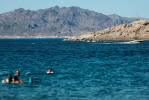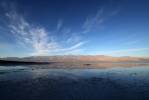Forecasters predict another down year for Lake Mead
Stop us if you’ve heard this one before: A lackluster year so far on the Colorado River has local water managers and National Park Service officials bracing for further declines at Lake Mead.
According to the latest federal forecast, released Wednesday, the reservoir is expected to fall to a new record low next month and slip downward from there, shedding a total of about 20 feet through June 2016.
The bleak new estimate is based on current projections pointing to below-average flows on the Colorado in the coming months, as the snow pack melts in the mountains that feed the river and its tributaries.
“We’re a bit low this year,” said Paul Miller, a senior hydrologist with the National Weather Service’s Colorado Basin River Forecast Center in Salt Lake City. “We’re only forecasting about 71 percent of average” flow into Lake Powell, Lake Mead’s upstream neighbor on the Arizona-Utah border.
The disappointing runoff is a result of below average snowfall in some areas and unusually dry soil conditions in others, resulting in more snow moisture being absorbed into the ground before it can reach the river, Miller said.
Conditions are particularly bad for the second straight year along the San Juan River Basin in the Four Corners area of Arizona, Utah, Colorado and New Mexico.
This would mark the 12th year since 2000 that the Colorado has seen below-average flows.
The past 15 years have been so bad they are dragging down the 30-year average federal forecasters use to gauge what passes for “normal” on the famously fickle river.
Miller said the current 30-year average for annual flow into Lake Powell, based on data from 1981 through 2010, is 10.8 million acre-feet. The average annual flow into Powell during the previous 30-year period — 1971 through 2000 — was nearly 11.8 million acre-feet.
That 1 million acre-foot difference represents a four-year supply of water for the Las Vegas Valley, where one-acre foot is enough to supply two average homes for just over a year.
The valley draws 90 percent of its water from Lake Mead, and most returns there after use.
The Southern Nevada Water Authority is almost finished with a new deep-water intake pipe designed to keep water flowing to the community even as the reservoir shrinks. Water authority spokesman Bronson Mack said the $817 million intake is on track to begin delivering water in August.
The wholesale water agency is about to go out to bid on a roughly $650 million pumping station that will allow the new intake to draw water from the deepest part of Lake Mead even if the reservoir drops low enough to shut down the authority’s two existing intake pipes.
Though they clearly aren’t banking on it, authority officials are still holding out hope for a rebound on the river this year. All it would take is some heavy, wet spring snows in March, April and even May, Mack said.
“We’re cautiously optimistic we could see another storm come through and dump some more snow. That number could still change a little bit,” he said.
In January 2000, Lake Mead was close to full with a surface elevation of 1,214 feet above sea level.
Today, the surface of the lake sits at about 1,088 feet above sea level, a difference of more than 125 feet.
The latest projections from the U.S. Bureau of Reclamation call for Lake Mead to dip below elevation 1,080 next month for the first time since it was being filled behind the newly constructed Hoover Dam in 1937.
That would break the current record low of 1,080.19 feet above sea level set last August, but any new mark is unlikely to last.
Bureau forecasters expect the lake to drop to elevation 1,073 by the end of June, then slowly add about 10 feet of water through next January before falling again, this time to about 1,067 feet above sea level mark by June of 2016.
Officials at Lake Mead National Recreation Area are also watching the Colorado River anxiously.
Though Lake Mead still boasts more than 125 square-miles of open water and roughly 400 miles of shoreline, access is an issue. Since the drought began on the Colorado, the shrinking lake has lost three boat launch ramps and three marinas even while the park has spent about $40 million to extend other ramps, roads and utility lines; build new parking lots; move docks and navigational aids for boaters; and mark new hazards on land and water.
Another $5 million worth of low-water work is planned this year to chase the receding shoreline.
“We’re going to make every effort to maintain launch ramp access for our visitors as the water declines,” said Jennifer Haley, chief of resource management and visitor services at Lake Mead.
That effort is expected to get underway in late spring or early summer, when construction crews should find plenty of newly dry land on which to work.
Contact Henry Brean at hbrean@reviewjournal.com or 702-383-0350. Follow @RefriedBrean on Twitter.
































